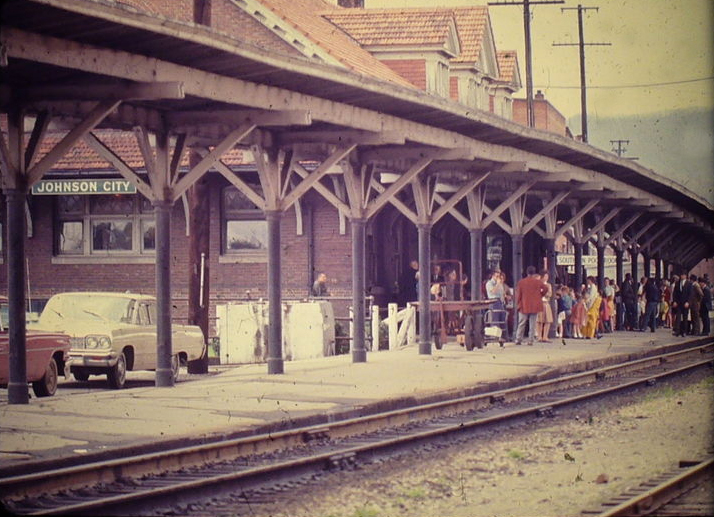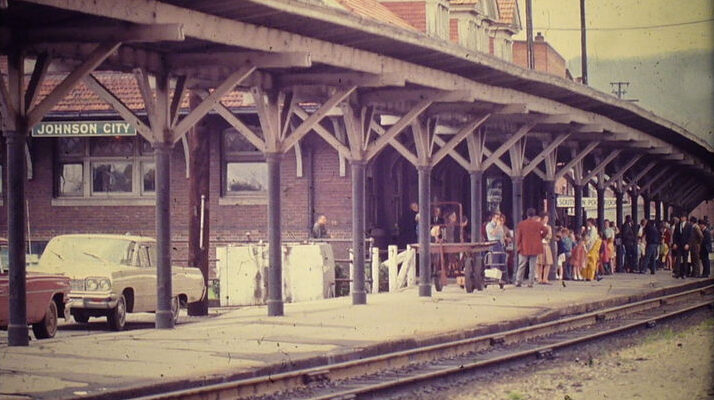Today’s column photo should take many of my readers on a nostalgic journey back to the old long ago razed Southern Railway Depot. It was a fun place to go, especially when trains arrived and departed. It was even more pleasurable to purchase a ticket and ride the rails. My subject concerns an unpleasant incident – a train wreck.
The collision occurred in Johnson City on Dec. 21, 1956, resulting in a fatality and two injuries. Specifics of the tragedy were described in a detailed Feb. 1, 1957 Interstate Commerce Commission report. The accident happened within the yard limits of Johnson City on a single-track line over which trains were operated by timetable, train orders and an automatic block-signal system.

According to my source, Work Extra 6507, a maintenance service train, was comprised of a diesel engine, eight cars and a caboose. It departed westbound from the east siding at Johnson City about 6:30 a.m. and stopped on the main track where the locomotive was detached and moved onto the middle siding.
No. 73, a westbound second-class freight train consisted of four diesel engines, coupled in multiple-unit control, 62 cars and a caboose. It departed from Bristol at 5:30 a.m., being seven hours late. It stopped briefly at signal 23.9A in Johnson City. The signal light indicated, “Proceed.” About 15 minutes later, after some cars had been removed and others added to the train, it continued on its journey.
Suddenly while the train was chugging along at about 10 miles per hour, it struck the rear end of No. 6507, pushing it 265 feet down the track and destroying its caboose. Three section men were riding in the caboose. One was killed and the other two were injured. The front end of No. 73 and the rear car of No. 6507 incurred some damage.
Early that morning, the crew of the service train reported for duty at Johnson City and assembled the train on the east siding. The locomotive then moved on the main track from the east siding-switch to the west siding-switch, entering the siding at the latter switch and was coupled to the west end of the train. It was then moved to the east switch of the middle siding and the locomotive was detached and moved onto the siding for the purpose of adding additional cars to the train. The conductor said that his plan was to enter the siding and permit No. 73 to pass. He said that a lighted red lantern and the red reflectorized disc, which served as a marker, were displayed at the rear of the caboose.
Before No. 73 reached the station at Johnson City, the engineer saw a yard locomotive pass by and assumed that it was the same one he had seen earlier. As the freight locomotive passed the station, the operator handed the fireman copies of three train orders and a clearance form. Almost immediately, he spotted the caboose of No. 6507 about 30 feet ahead of them and instantly applied the brakes, but it was too late to avoid a collision.
Contributing factors to the accident were a light rain and the early morning darkness. The front brakeman testified that dirt on portions of the front windows was not being cleaned sufficiently by the wipers, obstructing his view of the track ahead. He acknowledged that he did not see the caboose until seconds before the collision occurred. Crewmembers concurred that the large train was moving at about 10 miles per hour at the time of impact.
The official accident review, an impressive detailed report, noted that because of the curvature of the track and a building situated north of the track, the caboose could not have been seen until the locomotive was within 658 feet east of the accident site. The reflectorized disc, which served as a marker, was not visible by the big train until it was 380 feet from the small one.
The ruling by the Commission further stated that the accident was caused by failure to maintain a proper lookout ahead while moving within yard limits. Corrective policy changes were implemented by the company.

Comments are closed.